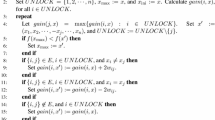Abstract
The global optimization method based on discrete filled function is a new method that solves large scale max-cut problems. We first define a new discrete filled function based on the structure of the max-cut problem and analyze its properties. Unlike the continuous filled function methods, by the characteristic of the max-cut problem, the parameters in the proposed filled function does not need to be adjusted. By combining a procedure that randomly generates initial points for minimization of the proposed filled function, the proposed algorithm can greatly reduce the computational time and be applied to large scale max-cut problems. Numerical results and comparisons with several heuristic methods indicate that the proposed algorithm is efficient and stable to obtain high quality solution of large scale max-cut problems.
Similar content being viewed by others
References
Abraham, D., Ángel, S., Felipe, F., Raúl, C.: A low-level hybridization between memetic algorithm and VNS for the max-cut problem. In: GECCO’05, pp. 999–1006, 25–29 June, Washington, DC, USA (2005)
Alizadeh, F., Haeberly, J., Nayakkankuppam, M., Overton, M., Schmieta, S.: SDPPACK User’s Guide: Version 0.9 beta for MATLAB 5.0 (1997)
Alperin, H., Nowak, I.: Lagrangian smoothing heuristics for max-cut. J. Heuristics 11, 447–463 (2005)
Barahona, F., Grötschel, M., Jünger, M., Reinelt, G.: An application of combinatorial optimization to statistical physics and circuit layout design. Oper. Res. 36, 493–513 (1988)
Bertsimas, D., Ye, Y.: Semidefinite relaxations, multivariate normal distributions, and order statistics. In: Du, D.-Z., Pardalos, P. (eds.) Handbook of Combinatorial Optimization, pp. 1–17. Kluwer Academic Publishers (1998)
Burer, S., Monteiro, R.D.C., Zhang, Y.: Rank-two relaxation heuristics for max-cut and other binary quadratic programs. SIAM J. Optim. 12, 503–521 (2001)
Choi, C., Ye, Y.: Solving sparse semidefinite programs using the dual scaling algorithm with an iterative solver. Manuscript, Department of Management Sciences, University of Iowa, Iowa City, IA 52242 (2000)
Festa, P., Pardalos, P.M., Resende, M.G.C., Ribeiro, C.C.: Randomized heuristics for the max-cut problem. Optim. Methods Softw. 17, 1033–1058 (2002)
Garey, M., Johnson, D., Stochmeter, L.: Some simplified NP-complete graph problems. Theor. Comput. Sci. 1, 237–267 (1976)
Ge, R.P.: A filled function method for finding a global minimizer of a function of several variables. Math. Program. 46, 191–204 (1990)
Ge, R.P., Huang, C.B.: A continuous approach to nonlinear integer programming. Appl. Math. Comput. 34(1), 39–60 (1989)
Goemans, M.X., Williamson, D.P.: Improved approximation algorithms for maximum cut and satisfiability problems using semidefinite programming. J. Assoc. Comput. Mach. 42(6), 1115–1145 (1995)
Gu, Y.H., Wu, Z.Y.: A new filled function method for nonlinear integer programming problem. Appl. Math. Comput. 173, 938–950 (2006)
He, X.L., Xu, C.X., Zhu, C.C.: A new class of filled functions for global minimization. In: Computation Intelligence and Security, Part I. Proceedings. Lecture Notes in Artifical Intelligence, vol. 3801, pp. 1088–1093 (2005)
Helmberg, C., Rendl, F.: A spectral bundle method for semidefinite programming. SIAM J. Optim. 10(3), 673–696 (2000)
Karp, R.M.: Reducibility among combinatorial problems. In: Miller, R., Thatcher, J. (eds.) Complexity of Computer Computations, pp. 85–103. Plenum Press, New York (1972)
Liu, X.: Finding global minima with a computable filled function. J. Global Optim. 19, 151–161 (2001)
Ng, C.K., Zhang, L.S., Li, D., Tian, W.W.: Discrete filled function method for discrete global optimization. Comput. Optim. Appl. 31, 87–115 (2005)
Orlova, G.I., Dorfman, Y.G.: Finding the maximal cut in a graph. Eng. Cybern. 10, 502–506 (1972)
Shang, Y.L., Zhang, L.S.: A filled function method for finding a global minimizer on global integer optimization. J. Comput. Appl. Math. 181, 200–210 (2005)
Xu, C.X., He, X.L., Xu, F.M.: An effective continuous algorithm for approximate solutions of large scale max-cut problems. J. Comput. Math. 24(6), 749–760 (2006)
Xu, Z., Huang, H.X., Pardalos, P.M., Xu, C.X.: Filled functions forunconstr ained global optimization. J. Global Optim. 20, 49–65 (2001)
Zhang, L.S., Ng, C., Li, D., Tian, W.W.: A new filled function method for global optimization. J. Global Optim. 28, 17–43 (2004)
Zhu, W.X.: An approximate algorithm for nonlinear integer programming. Appl. Math. Comput. 93(2–3), 183–193 (1998)
Zwick, U.: Outward rotations: a tool for rounding solutions of semidefinite programming relaxations, with applications to max cut and other problems. In: Proc. of 31th STOC, pp. 679–687 (1999)
Author information
Authors and Affiliations
Corresponding author
Additional information
This work is supported by National Natural Science Foundations of China (71001045, 10971162), Jiangxi Educational Committee Science Foundation for Youths (GJJ10114) and Jiangxi University of Finance and Economics Support Program funds for outstanding youths.
Rights and permissions
About this article
Cite this article
Ling, Af., Xu, Cx. A new discrete filled function method for solving large scale max-cut problems. Numer Algor 60, 435–461 (2012). https://doi.org/10.1007/s11075-011-9522-1
Received:
Accepted:
Published:
Issue Date:
DOI: https://doi.org/10.1007/s11075-011-9522-1




